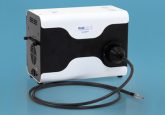5 reasons to choose LED microscopy illumination for a confocal setup

LED Illumination Systems are becoming more popular components for confocal setups. They replace the mercury or metal halide lamps for widefield fluorescence observation used when setting up a confocal laser scanning experiment – and here are three reasons why:
- Low maintenance
Bulbs frequently need replacing, which can be a challenge when accessing the lamp housing of a large confocal system. Moreover, the alignment required after replacing a bulb each time is tricky. LEDs are long-lived and also factory aligned, ready to be fitted to the microscope. This also saves cost, since disposing of mercury bulbs requires a specialist service.
- Optimising sample irradiance is simple
Did you know? A light source at full power has been shown to reduce the fluorescence of Alexa Fluor 488 by half in just three seconds.1 Using gentle illumination during observation will therefore help avoid damaging the sample by phototoxicity and photobleaching before the confocal experiment has even begun – and this is easier with LEDs. Traditional lamps require neutral density filters for modulation, whereas LED illumination systems can be controlled from 1-100% using simple sliders either on a control pod, graphical user interface or imaging software.
- Instant on/off
Lamps require a warm-up and cool-down time before they can be safely switched on again. LEDs can instead be switched on and off instantly as required during sample observation, which means they don’t need to be left on all day. This leads to extra benefits…
- Sustainable & energy efficient
A mercury lamp can consume more than 10 times more energy over 25,000 hours of use compared to an LED Illumination System.2 Mercury is also toxic, posing a health and safety risk to laboratory staff, as well as the environment.
- Cost-effective over time
Improved energy efficiency and removing the need for mercury disposal costs combine to make LEDs the more cost-efficient option over time. An independent study calculated a potential saving of £30,000 over 25,000 hours of usage with an LED Illumination System.2
Which Illumination System?
The two most popular systems for this application are the pE-300lite, which offers simple white light as a direct replacement to a lamp, and the pE-300white where each LED channel can be independently controlled (and this can also be controlled in software).
The pE-4000 is often selected for microscopes which include several laser lines for a variety of different fluorophores. This is because it has the widest selection of wavelengths and users can easily illuminate samples at similar wavelength as the laser.
For sensitive samples, sample observation using transmitted illumination is gentle, and the pT-100 offers the greatest protection against phototoxicity and photobleaching.
If you would like to find out more about LED illumination for confocal laser scanning microscopy setups, speak to your local reseller or please get in touch with CoolLED.
This content was supplied by CoolLED.





